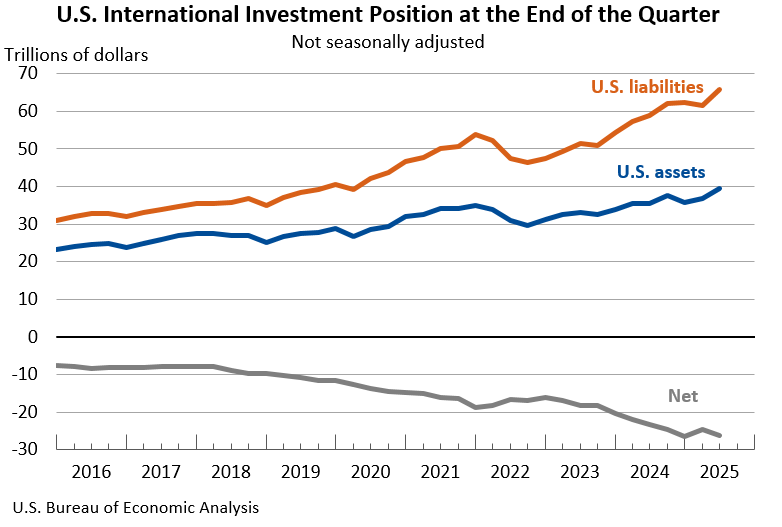Bureau of Economic Analysis
U.S. International Investment Position, 2nd Quarter 2025
The U.S. net international investment position, the difference between U.S. residents’ foreign financial assets and liabilities, was -$26.14 trillion at the end of the second quarter of 2025, according to statistics released today by the U.S. Bureau of Economic Analysis. Assets totaled $39.56 trillion, and liabilities were $65.71 trillion. At the end of the first quarter, the net investment position was -$24.65 trillion (revised).
Principal Federal Economic Indicators
Noteworthy
The Latest
2014 GDP by State Statistics to be Released June 10
Statistics on the 2014 economic performance of all 50 states and the District of Columbia, will be released Wednesday, June 10 at 8:30 a.m. EDT by the U.S. Bureau of Economic Analysis.
April 2015 Trade Gap is $40.9 Billion
The U.S monthly international trade deficit decreased in April 2015 according to the U.S. Bureau of Economic Analysis and the U.S. Census Bureau. The deficit decreased from $50.6 billion in March (revised) to $40.9 billion in April, as exports increased and imports decreased. The previously published March deficit was $51.4 billion. The goods deficit decreased $9.3 billion from March to $60.7 billion in April. The services surplus increased $…
U.S. International Trade in Goods and Services, April 2015
U.S. Census Bureau U.S. Bureau of Economic Analysis NEWS U.S. Department of Commerce * Washington, DC 20230 U.S. INTERNATIONAL TRADE IN GOODS AND SERVICES April 2015 The U.S. Census Bureau and the U.S.
U.S. International Trade in Goods and Services, 2015 Annual Revision
U.S. Census Bureau U.S. Bureau of Economic Analysis NEWS U.S. Department of Commerce * Washington, D.C. 20230
U.S. International Trade in Goods and Services
Annual Revision for 2014
Disposable Income Rises in April
Personal income increased 0.4 percent in April after increasing less than 0.1 percent in March. Wages and salaries, the largest component of personal income, rose 0.2 percent in April after rising 0.1 percent in March.
Current-dollar disposable personal income (DPI), after-tax income, increased 0.4 percent in April after rising less than 0.1 percent in March, reflecting increases in income receipts on assets and wages…
Personal Income and Outlays, April 2015
Personal income increased $59.4 billion, or 0.4 percent, and disposable personal income (DPI) increased $48.8 billion, or 0.4 percent, in April, according to the Bureau of Economic Analysis. Personal consumption expenditures (PCE) decreased $2.6 billion, or less than 0.1 percent.
First-Quarter GDP Revised Down: "Second" Estimate of GDP
Real gross domestic product (GDP) decreased 0.7 percent in the first quarter of 2015, according to the “second” estimate released by the Bureau of Economic Analysis. The growth rate was revised down 0.9 percentage point from the “advance” estimate released in April. In the fourth quarter of 2014, real GDP increased 2.2 percent.
GDP highlights The first-quarter decline in real GDP reflected declines in the following:
Gross Domestic Product, 1st quarter 2015 (second estimate); Corporate Profits, 1st quarter 2015 (preliminary estimate)
Real gross domestic product -- the value of the production of goods and services in the United States, adjusted for price changes -- decreased at an annual rate of 0.7 percent in the first quarter of 2015, according to the "second" estimate released by the Bureau of Economic Analysis. In the fourth quarter, real GDP increased 2.2 percent. The GDP estimate released today is based on more complete source data than were available for…
BEA's New Data Tool Provides Fast Access to Trade and Investment Stats for Countries
A new data tool–International Trade and Investment Country Facts Application–on the Bureau of Economic Analysis website gives users a snapshot of statistics on trade and investment between the United States and another country by simply clicking on a world map.
These fast facts at your fingertips can include:
BEA Works to Mitigate Potential Sources of Residual Seasonality in GDP
The Bureau of Economic Analysis (BEA) is working on a multi-pronged action plan to improve its estimates of gross domestic product (GDP) by identifying and mitigating potential sources of “residual” seasonality. That’s when seasonal patterns remain in data even after they are adjusted for seasonal variations.




